Chris Kridler
Chris Kridler is a writer, photographer and storm chaser and author of the Storm Seekers Series of storm-chasing adventures.
Chris Kridler is a writer, photographer and storm chaser and author of the Storm Seekers Series of storm-chasing adventures.

Covered bridge in Somerset County, Pennsylvania.
It’s funny, the romantic notions we have of covered bridges, but this was no Bridges of Somerset County romance novel. Many of the bridges are no longer in regular use; they sit parallel to the main road’s bridges, or are even blocked off in historical parks. But with a little imagination, you can frame them nicely and transport yourself in time.
So much of photography is illusion – or call it artistic choice, if you like. I chose to go for a saturated look that brought out the middling fall colors. I love catching the flashy foliage as the trees throw their annual party before going to sleep for the winter, as much as I love coming home to the perpetual green of Florida.
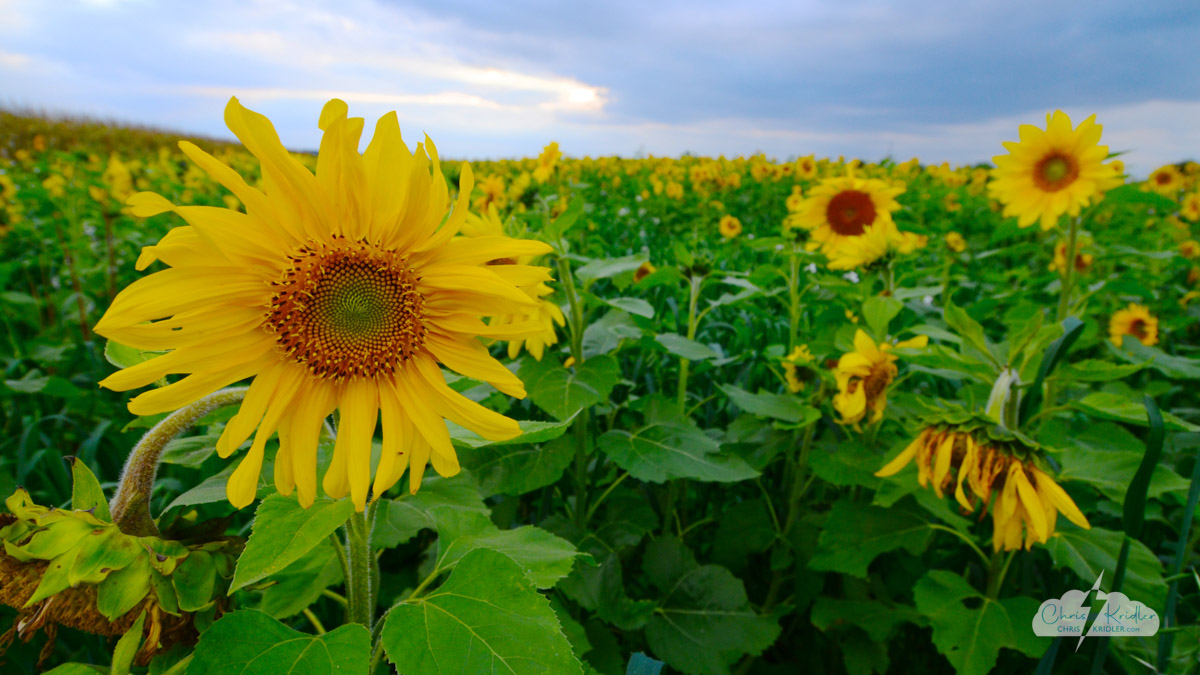
Pennsylvania sunflower field.
I also took a few shots of a sunflower field in Lancaster County – home of so many Amish buggies, rolling farms, and fruit stands overflowing with pumpkins. Sunflowers always make me think of Kansas, now that storm chasing is in my blood. Seeing them in full bloom in Kansas is something I haven’t yet experienced, since I live in Florida; that’s a trip I look forward to.
Roll over a photo to see a caption, or click on any image to start a slide show.
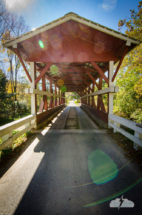
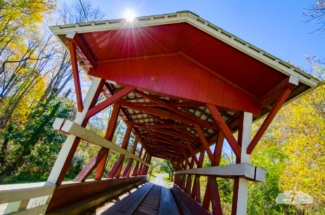
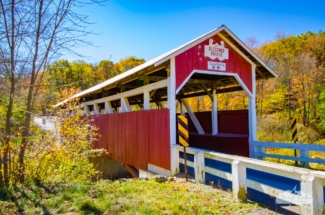
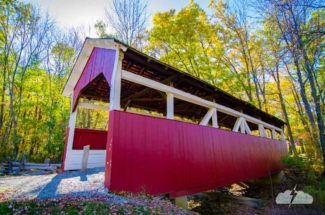

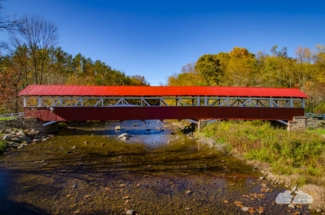
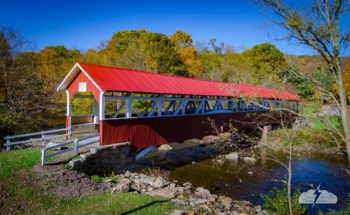
First, come out to the Melbourne Independent Filmmakers’ Festival tonight and Saturday. There’s a full slate of fascinating films and other programming planned, from the comedy show tonight to the Florida Filmmakers Matinee Saturday starting at 9 a.m. That’s when you can see my documentary, “Hourglass,” about sand sculptors battling the weather and the clock to prepare for the Art of Sand festival. Get tickets and see the schedule for the event, at The Oaks Premiere Theaters in Melbourne.
Also, at noon on Monday, you can hear me chatting with Seeta Durjan Begui on “Seeta and Friends” on WMEL-AM radio. You can listen online.
Monday evening at 7 p.m., come to a free storm-chasing presentation at the Eau Gallie Library (sponsored by Friends of the Eau Gallie Library). I’ll be talking about the realities of storm chasing, showing video and photos and my short documentary “Chasing Reality,” and signing copies of my novel “Funnel Vision.” That’s the storm-chasing adventure to which I’m writing a sequel right now!
Learn more about upcoming events in my calendar.
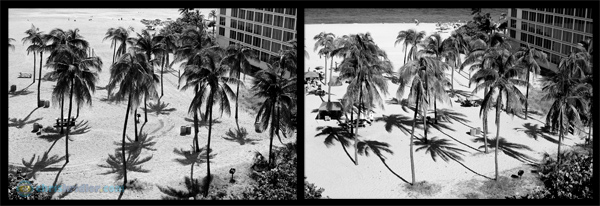
Shadow play among Fort Lauderdale’s palm trees, morning and afternoon. Click through to see a larger version. Photo by Chris Kridler, ChrisKridler.com, SkyDiary.com
When you’re writing a novel, and you’ve set your own deadlines, it’s not as easy to be disciplined. Still, when I’m in the groove, I can write almost as fast as I wrote newspaper articles. Except … sometimes, there’s a block. A rock in the road. And the story keeps running into it. I recently spent a while looking at a rock like that. I’m working on the sequel to Funnel Vision, and though I have a pretty thorough outline, there was a spot in the middle that didn’t have a way through. Because a story can’t just jump from one mile to the next without a reason, just as it can’t creep toward something and never get there (unless, perhaps, that’s the intention, a la Samuel Beckett).
I think it took a weekend away, looking at the changing light on the ocean and the shifting shadows of the palm trees, to realize I’d just have to walk around the rock and see where it took me. I needed to see it from the other side and let the characters choose a new path. And then the story started to flow again.
Remember that old “Saturday Night Live” skit in which Stephen King is being interviewed, typing the entire time, and for one second says he has writer’s block – then keeps on writing? It was pretty funny, knowing how prolific he is, but that state of dedication is enviable. If you’ve read his memoir, you know it didn’t come easy. (And all work and no play makes Jack a dull boy.)
Everyone has a different way of writing, and I think I’m learning that my characters feel imprisoned in too much premeditated structure, as do I. So I’m going to try to build my outlines out of balsa wood instead of steel and see what happens … and keep an eye on how the shadows change.
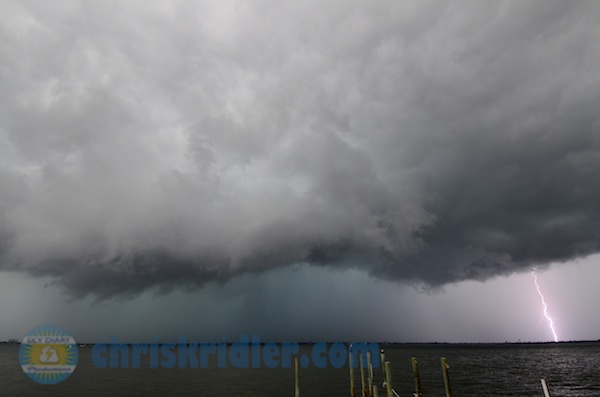
The Aug. 17 storm was really electric, as seen from Melbourne looking east over the Indian River Lagoon. Photo by Chris Kridler, ChrisKridler.com, SkyDiary.com
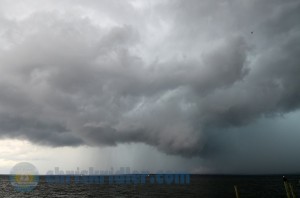
I missed the Brevard County funnel clouds on Aug. 17 but caught the tail end of the line heading out to sea. Photo by Chris Kridler, ChrisKridler.com, SkyDiary.com
So after my last assignment, I rushed north to Melbourne to catch the tail end of the storms as they went out to sea. The motion and structure were pretty, but I didn’t see any funnels – just a deceptive feature that was sort of the right shape, but not, as far as I could tell, the real thing. The feature, which appears to consist of condensing scud clouds, is pictured below (at right in photo). At least I got a lucky daytime lightning bolt. I definitely didn’t have “Funnel Vision” on Friday!
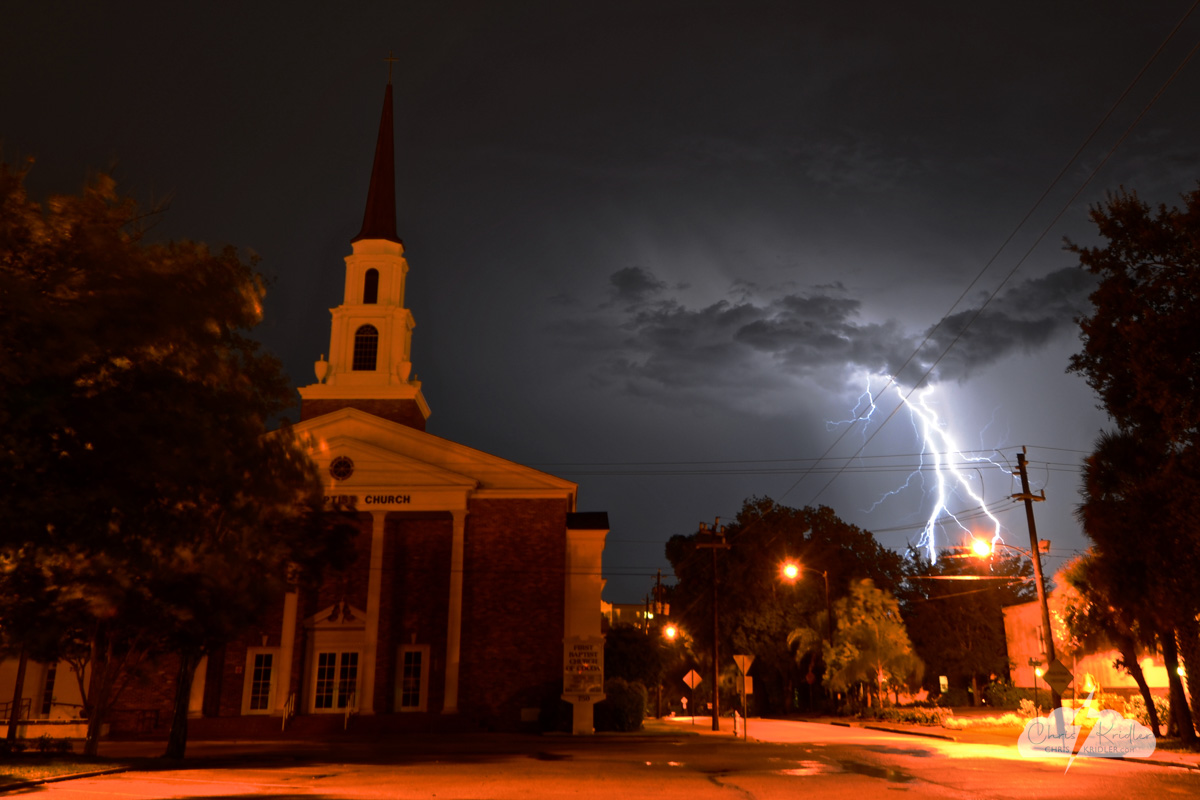
Lightning in Cocoa, Florida. Photo by Chris Kridler, ChrisKridler.com, SkyDiary.com
I got a few photos that may be of academic interest, if not as artistic as I’d like. There were technical challenges, one being that most of the bolts were embedded in rain. Another was that during the ten minutes they were really good, I was driving and stuck at Cocoa’s many stubborn traffic lights.
I headed to Port St. John, then meandered west to near the Lone Cabbage Fish Camp in west Cocoa. I got a few OK shots there, but when I was headed back east, the blob of precipitation that was heading offshore exploded with cloud-to-ground strikes when I was in no position to shoot them. Figures. I finished with a few shots in Cocoa and then along the Indian River Lagoon.
Roll over a photo to see a caption, or click on any image to start a slide show.
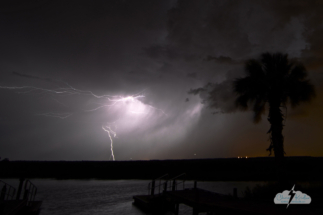
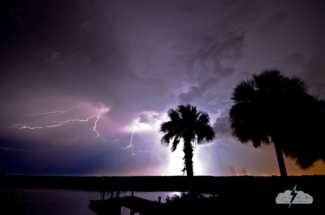
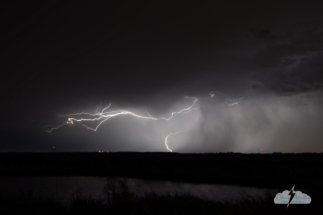
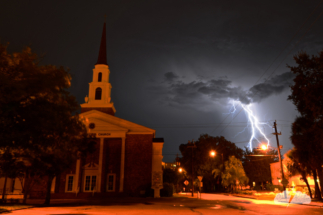
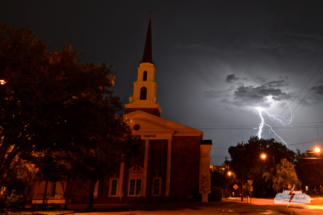
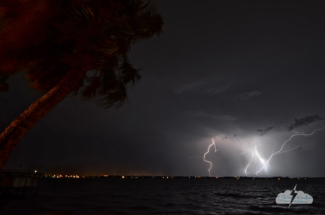



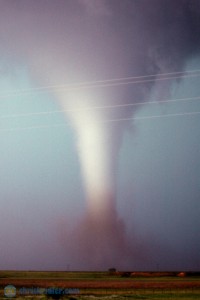
This tornado near South Plains, Texas, was followed by baseball- and softball-size hail on May 12, 2005. Photo by Chris Kridler, ChrisKridler.com, SkyDiary.com
Even worse was May 12, 2005, near South Plains, Texas, a day that was at least partially redeemed by the really nice tornado that preceded the assault. I’ve remastered my video and produced a new edit that I’ve uploaded to YouTube (below).
All of my hail encounters helped inform the hail barrage that happens during one of the action sequences in my novel Funnel Vision. I once took shelter in a country airport, for instance, though it was in Colorado, not Kansas. And if you turn up the sound in this video, you’ll understand that visceral, chilling feeling of having your car destroyed while you’re still inside it. Enjoy.
Note: For best quality, roll your cursor over the lower right of the video window, click on the gear symbol, and choose 720p HD.
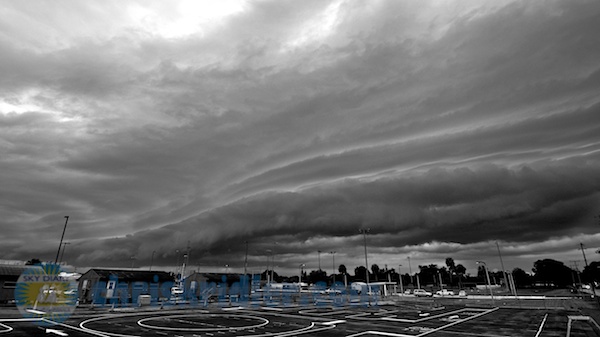
A shelf cloud sweeps over Rockledge High School in east-central Florida on Aug. 8, 2012. Photo by Chris Kridler, ChrisKridler.com, SkyDiary.com
I’ve been longing for nighttime lightning, as I always do during Florida’s summers. I want to photograph it, of course, but there’s just not as much of it as you might think. Often, storms fire early and shoot off outflow boundaries, sometimes in the form of sweeping shelf clouds like this one in Rockledge on Wednesday. I’m still hoping for more!
Meanwhile, the tropics are active. While hurricanes are fascinating, mostly, I think they’re more pain than pleasure. They present fewer photographic opportunities, unless you’re on the International Space Station, and they cause a lot of misery. However, if you’re into the violence of nature, as many storm chasers are, it’s hard to resist them. I’d rather chase tornadoes any day.
On Friday, make sure you check out my friend Kam Miller’s blog, Glass Half-Full in Hollywood. Kam is an experienced TV and film writer and offers fabulous advice straight from Hollywood’s movers and shakers. And speaking of shakers, she also features Friday cocktails on the blog. I’m guest-blogging there Friday about Tales of the Cocktail, the convention in New Orleans from which I just returned (and from which I’m still recovering). While I was there, I helped The Times-Picayune cover the event with blogs, photos and videos.
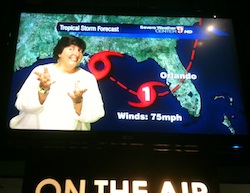
OK, so I probably won’t be doing any TV forecasting. It’s fun to pretend, though, in the faux studio at Orlando Science Center.
At OSC, you can also catch Sean Casey’s “Tornado Alley” IMAX movie, which has some beautiful storm footage and a neat little story about the frustrations and triumphs of the Vortex 2 tornado research team. Of course, the film also features Casey’s home-brewed tank, the Tornado Intercept Vehicle. He visited OSC recently. I won’t be bringing a tank, but I will bring a piece of a car that was trashed by hail!
Thanks to the Orlando Sentinel’s Theme Park Rangers for noting my appearance Saturday. Also, OSC interviewed me by phone and shaped my answers into wee nuggets for its blog. I have more events coming up, which you can find in my new calendar: storm-chasing talks, book signings, and another talk about storm photography in Vero Beach.
I was wavering between amusement and horror today as I watched two friends take on the publishing revolution in a battle of 140-character grenades on Twitter. They made good points: Digital’s rise is formidable. Self-publishing pundits are “post-apocalyptic” about traditional publishing. And so on. But I started to worry about the vitriol I see in the wider debate about traditional vs. self-publishing. Why must it be one or the other?
There are people out there who love books but seem to hate, well, everybody on the other side. As if there were another side. As writers (and as publishers, self- or otherwise), I think we’re on the side of telling great stories. Or at least some of us are; even in my most Pollyanna moments, I have to admit that some people just want to make a buck, or many millions of bucks, as rare as that kind of success may be. Vintage Books didn’t pick up the “Fifty Shades” trilogy because of its literary value. Some maudlin bestsellers seem more cynical than sincere. And publishing, big or small, is a business, and writers will make decisions accordingly.
Still, even though making money from writing is a kind of validation, or ideally, a living, it’s not the main reason most writers write.
Perhaps it’s not true of you, Writer, but I think most writers, whether they aim to create great art or craft the perfect thriller, ultimately want to be read. To be read, one must be published, one way or the other. How we publish books is important to their success, but I don’t think one’s strategy has to be all or nothing, Us vs. Them. But that’s the way the discussion unfolds. Wordsmiths turn into cornered animals. Given the upheaval in publishing, it’s no wonder the traditionals feel threatened and the upstarts feel defensive. Livelihoods and reputations are at stake. I’ve seen self-publishing advocates eviscerate traditional publishers for being short-sighted and rapacious (see Jessica Clark’s screed, which is compelling partly because she came from traditional publishing). I’ve seen traditionally published authors snark about the unwashed self-published, whose books, by definition, must suck.I hate to be sensitive to the latter stance, but I am, a little. Though I once had similar opinions, I chose to self-publish earlier this year after going through several rounds of traditional-pub rejection and years of angsting and revisions. I did it not because I think it is the one shining path to revolution, but because it just made sense for me. My novel apparently defied genre, I wasn’t getting any younger, I was actually happy with it, and self-publishing was exploding. It was a business and personal decision. I made back my expenses, and I’m glad it’s out there.
But never mind my book. I know writers who are still struggling to get published the traditional way, writers I’ve worked with closely over glasses of wine, and their stuff is brilliant. But agents/publishers haven’t wanted these brilliant books for whatever reason, and I fear they will never be read beyond a few lucky critique partners. That’s enough reason to self-publish a book.
Sure, a lot of self-published books still stuck – as do some traditionally published books. I always think of Flannery O’Connor’s response to the question of whether universities discourage young writers: “My opinion is that they don’t stifle enough of them. There’s many a best seller that could have been prevented by a good teacher.” (1)
In the case of self-publishing, stifling is elusive. The vetting process is what’s missing, for good or ill, when you take away the traditional publishing grinder. We all need friction to smooth the rough edges. We need smart people to critique and edit our books before they see daylight. As a journalist and frequent book reviewer, I used to see many, many self-published books cross my desk. Long memories of poor design, bad grammar and amateur efforts mean the stigma will linger. But we’re seeing many more of these books published at a professional level, shaped if not screened by editors, and designed well. New and refreshing voices are emerging. Even if they are not bestsellers, they can find their niche. They can find their fans. They deserve to be heard, and not to be disdained without cause. And self-publishing also offers an option for traditionally published authors who want to stretch beyond what they’re told will sell, or who want to promote their work in a new way. (It’s Us and Them.)
Once published, all books should be held to the same standard (or the standard that fits – whether it does what it aims to achieve). I’m agog to hear critics and book bloggers say some self-pubbed authors have scared them off because said authors freak out if a review isn’t favorable or ask them to be “nicer” because the book is self-published. These unprofessional writers taint the rest, and more education is in order.
Even if all books are held to the same standard, traditionally published books still have the advantage of reach and marketing (or at least a publisher’s A-list books do). The big houses have already earned the respect of traditional media, who remain wary of embracing self-published books. As a recent graduate of newspapers, I can say that attitude is slowly changing, even as coverage of books is shrinking. But in the realm of media attention, the traditionals are likely to have the advantage for a long time. I definitely read more traditionally published books than self-published ones, because their media advantage makes them easier to discover.
Consequently, when it comes to marketing, self-publishers do sometimes smell a bit desperate. Blogs for “indie” writers tend to be much more about promotion and platforms and getting reviews, about Amazon and the effectiveness of giveaways (or should I say the glut of giveaways), than about writing. And that’s OK. I’ve learned a ton from these blogs. But the key is still writing a really good, professionally packaged book. That book will not exist in an indie vacuum. It is one of millions published each year around the world, and it has to earn a place in a much larger literary landscape.
We’ve entered an era when even an unconventional, unproven, transcendent writer can hope to see his book in print, no matter how small the publishing scale. The hope is that the good books will get respect. With time and luck, they should do so, no matter how they’re published.
